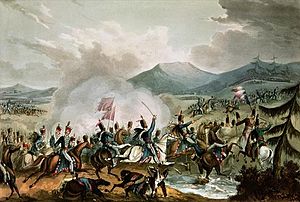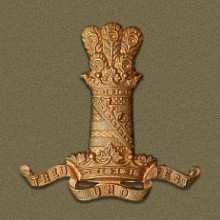
The 11th Hussars (Prince Albert's Own) was a cavalry regiment of the British Army established in 1715. It saw service for three centuries including the First World War and Second World War but then amalgamated with the 10th Royal Hussars (Prince of Wales' Own) to form the Royal Hussars in 1969.

The King's German Legion was a British Army formation consisting of expatriate German soldiers which existed from 1803 to 1816. It achieved the distinction of being the only German military force to fight without interruption against the French and their allies during the Napoleonic Wars.

The 10th Royal Hussars (Prince of Wales's Own) was a cavalry regiment of the British Army raised in 1715. It saw service for three centuries including the First World War and Second World War but then amalgamated with the 11th Hussars (Prince Albert's Own) to form the Royal Hussars (Prince of Wales's Own) in October 1969.

The 13th Hussars was a cavalry regiment of the British Army established in 1715. It saw service for three centuries including the Napoleonic Wars, the Crimean War and the First World War but then amalgamated with the 18th Royal Hussars, to form the 13th/18th Royal Hussars in 1922.

The 18th Royal Hussars (Queen Mary's Own) was a cavalry regiment of the British Army, first formed in 1759. It saw service for two centuries, including the First World War before being amalgamated with the 13th Hussars to form the 13th/18th Royal Hussars in 1922.

The Battle of Boxtel was fought in the Duchy of Brabant on 14–15 September 1794, during the War of the First Coalition. It was part of the Flanders Campaign of 1793–94 in which British, Dutch and Austrian troops had attempted to launch an invasion of France through Flanders. It is often remembered as being the debut action of Arthur Wellesley, who later became the 1st Duke of Wellington.
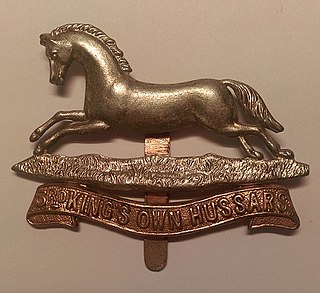
The 3rd Hussars was a cavalry regiment of the British Army, first raised in 1685. It saw service for three centuries, including the First and the Second World Wars, before being amalgamated with the 7th Queen's Own Hussars, to form the Queen's Own Hussars in November 1958.

The 4th Queen's Own Hussars was a cavalry regiment in the British Army, first raised in 1685. It saw service for three centuries, including the First World War and the Second World War. It amalgamated with the 8th King's Royal Irish Hussars, to form the Queen's Royal Irish Hussars in 1958.

The 15th The King's Hussars was a cavalry regiment in the British Army. First raised in 1759, it saw service over two centuries, including the First World War, before being amalgamated with the 19th Royal Hussars into the 15th/19th The King's Royal Hussars in 1922.
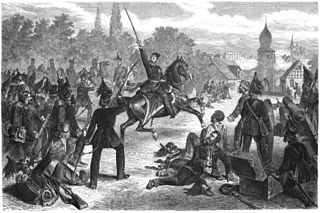
The Brunswick Ducal Field-Corps, commonly known as the Black Brunswickers, was a volunteer military unit raised by Frederick William, Duke of Brunswick-Wolfenbüttel during the Napoleonic Wars. The Duke was a strong opponent of Napoleon's occupation of German territory. Formed in 1809 when war broke out between the First French Empire and the Austrian Empire, the unit initially consisted of approximately 2,300 infantrymen and cavalrymen before incorporating a number of artillery troops.

Lieutenant-General Robert Ballard Long was an officer of the British and Hanoverian Armies who despite extensive service during the French Revolutionary and Napoleonic Wars never managed to achieve high command due to his abrasive manner with his superiors and his alleged tactical ineptitude. Although he remained a cavalry commander in the Peninsular War between 1811 and 1813, the British commander Wellington became disillusioned with Long's abilities. Wellington's opinion was never expressed directly, though when the Prince Regent manoeuvred his favourite, Colquhoun Grant into replacing Long as a cavalry brigade commander, Wellington conspicuously made no effort to retain Long. Other senior officers, including Sir William Beresford and the Duke of Cumberland, expressed their dissatisfaction with Long's abilities. The celebrated historian, and Peninsula veteran, Sir William Napier was a severe critic of Beresford's record as army commander during the Albuera Campaign; in criticising Beresford he involved Long's opinions as part of his argument. The publication of Napier's history led to a long running and acrimonious argument in print between Beresford and his partisans on one side, with Napier and Long's nephew Charles Edward Long on the other. Recently, Long's performance as a cavalry general has received more favourable comment in Ian Fletcher's revisionist account of the British cavalry in the Napoleonic period.
General Sir John "Black Jack" Slade, 1st Baronet, served as a general officer in the British Army during the Peninsular War. Slade was praised in official reports, including by Arthur Wellesley, 1st Duke of Wellington, who also voiced some criticisms of him privately. Slade received an Army Gold Medal, and was honoured three times with the thanks of Parliament. Slade's descendants include two admirals, namely son Sir Adolphus Slade and grandson Sir Edmond Slade. Despite achieving high rank during and after active soldiering, Slade was criticised as a general of cavalry by some contemporaries and historians.
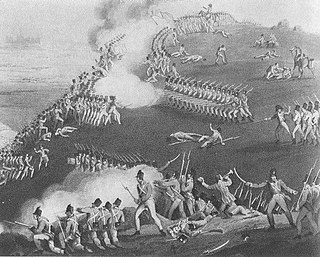
In the Battle of Castalla on 13 April 1813, an Anglo-Spanish-Sicilian force commanded by Lieutenant General Sir John Murray fought Marshal Louis Gabriel Suchet's French Army of Valencia and Aragon. Murray's troops successfully repelled a series of French attacks on their hilltop position, causing Suchet to retreat. The action took place during the Peninsular War, part of the Napoleonic Wars. Castalla is located 35 kilometers north-northwest of Alicante, Spain.
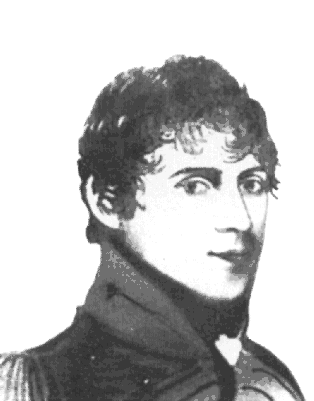
General Alexander Cavalié Mercer was a British Army officer of the Royal Horse Artillery. He is most notable as commander of G Troop Royal Horse Artillery at the Battle of Waterloo, and as author of Journal of the Waterloo Campaign.
Lieutenant General Sir John Colquhoun Grant was a British soldier.

Colonel Sir Augustus Simon Frazer, commanded the artillery at the British invasions of the Río de la Plata (1807) and the Royal Horse Artillery on Wellington's staff in the Peninsular War, and later during the Waterloo Campaign.

Lieutenant-General Sir Joseph Thackwell was a British Army officer. He served with the 15th Hussars in the Peninsular War at the Battle of Sahagún in 1808 and the Battle of Vitoria in 1813, and he lost his left arm at the Battle of Waterloo in 1815. He commanded the regiment from 1820 to 1832. He then served in India, commanding the cavalry in the First Anglo-Afghan War of 1838–89, and at the Battle of Sobraon in the First Anglo-Sikh War of 1845–46, and at the Battle of Chillianwala and Battle of Gujrat in the Second Anglo-Sikh War of 1848–9. He also commanded the 3rd The King's Own Dragoons, was colonel of the 16th Lancers, and was appointed Inspector-general of cavalry.

After the fighting at Quatre Bras the two opposing commanders Marshal Ney and the Duke of Wellington initially held their ground while they obtained information about what had happened at the larger Battle of Ligny. They received intelligence that the Prussian army under the command of Prince Blücher had been defeated by the French Army of the North under the command of Napoleon Bonaparte.
Major William Norman Ramsay (1782–1815) was a Scottish officer in the British Royal Horse Artillery who fought in the Napoleonic Wars, and was noted for his valour. He was killed in action at Waterloo. He was sometimes called Norman Ramsay.
George James Robarts CB, was a British politician who served Parliament for Wallingford.
